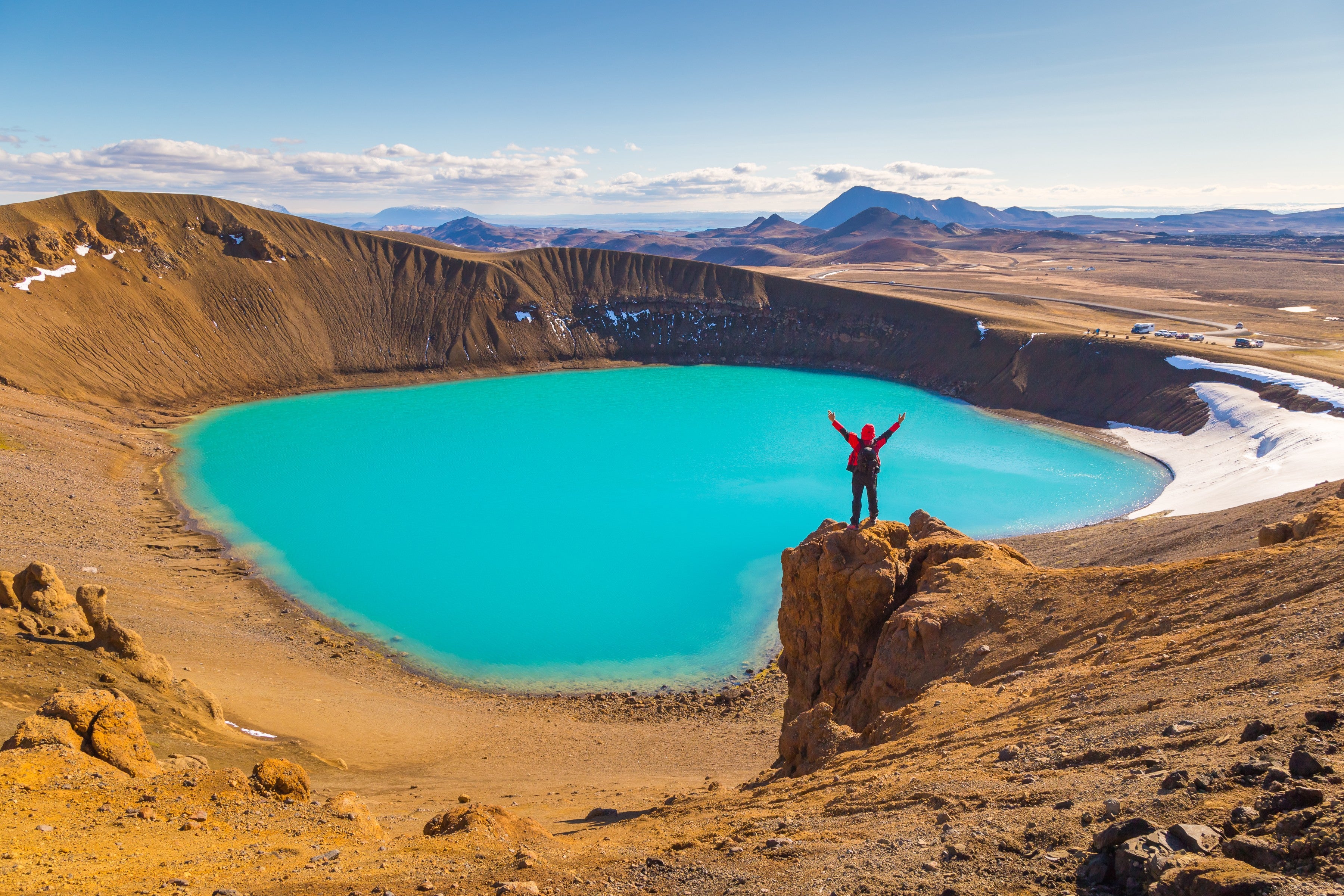Find out all you need to know about Iceland in April. Is April a good time to visit Iceland? What is the weather in Iceland in April? Will there still be snow? What activities can you do in April? Is it possible to see the northern lights?
April in Iceland marks a quiet transformation. As winter fades, longer days thaw frozen landscapes and bring a touch of warmth, though snow can still return overnight. This ever-changing season invites spontaneity and wonder, with plenty of April tours and spring excursions to take on.
For visitors, April presents an opportunity to explore Iceland during this transitional period. You can still join northern lights tours, enjoy glacier hikes and lava cave adventures, spot migratory birds, attend local festivals, and go on drives that capture the essence of Iceland spring travel.
Many travelers choose car rentals in April to enjoy the freedom of self-drive tours through Iceland’s dramatic landscapes. Finding comfortable accommodations in Iceland during this shoulder season is also often easier, providing a cozy base for your adventures.
This guide covers everything you need to know to make the most of visiting Iceland in April. Read on for tips about the weather, top activities, and what to expect throughout your trip.
Why You Can Trust Our Content
Guide to Iceland is the most trusted travel platform in Iceland, helping millions of visitors each year. All our content is written and reviewed by local experts who are deeply familiar with Iceland. You can count on us for accurate, up-to-date, and trustworthy travel advice.
Key Takeaways
-
April is a transition month with a mix of winter landscapes and early spring signs, longer daylight hours, and still-possible snowfall.
-
Many major routes are accessible, including the South Coast, Golden Circle, and Snaefellsnes Peninsula, but all Highland roads remain closed. A 4x4 vehicle is useful outside major areas.
-
Glacier hikes, hot springs, lava caves, scenic road trips, and early bird-watching are reliable April activities, with puffins usually arriving late April or early May.
-
Northern lights are still possible in early April, though sightings become rare as daylight increases through the month.
-
Festivals and cultural events begin to return, including Easter traditions, free music events, and family-friendly activities in Reykjavik.
Weather in Iceland in April
Iceland's weather in April changes quickly as winter gives way to spring, so don’t be surprised by sudden shifts in temperature or snowfall. The average temperature in Iceland in April typically ranges from 39 F to 44 F (3 C to 6.8 C), staying just above freezing in most regions.
The capital, Reykjavik, tends to be a few degrees milder than more rural areas, though snow and rain remain a possibility throughout the month. Rainfall begins to ease compared to March, but the weather in Iceland in April remains highly unpredictable.
Soft sunlight and patches of green can appear one moment. Then, without warning, a snowstorm may sweep across the land. You can think of it as early April still belonging to winter, while late April starts to feel more like spring.
Daylight in Iceland in April
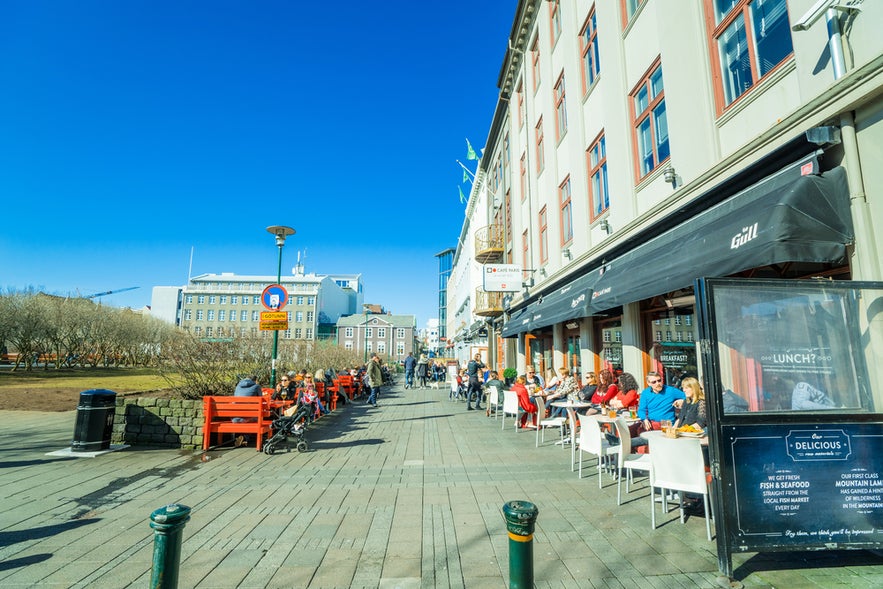 One of the most noticeable changes during April is the return of longer daylight hours as the season moves toward spring in Iceland. At the beginning of the month, the sun typically rises around 6:45 AM and sets just after 8:15 PM, offering about 13 hours of daylight.
One of the most noticeable changes during April is the return of longer daylight hours as the season moves toward spring in Iceland. At the beginning of the month, the sun typically rises around 6:45 AM and sets just after 8:15 PM, offering about 13 hours of daylight.
By the end of the month, Iceland's April daylight hours stretch to just over 16 hours, with sunrise at around 5:15 AM and sunset close to 9:25 PM in Reykjavik. This increase gives travelers plenty of time to explore, even on road trips or day trips that cover longer distances.
These extended daylight hours are ideal for sightseeing, photography, and experiencing Iceland’s April weather conditions. The long, lingering daylight becomes part of the experience as Iceland transitions to its famous midnight sun season.
Can You See the Northern Lights in Iceland in April?
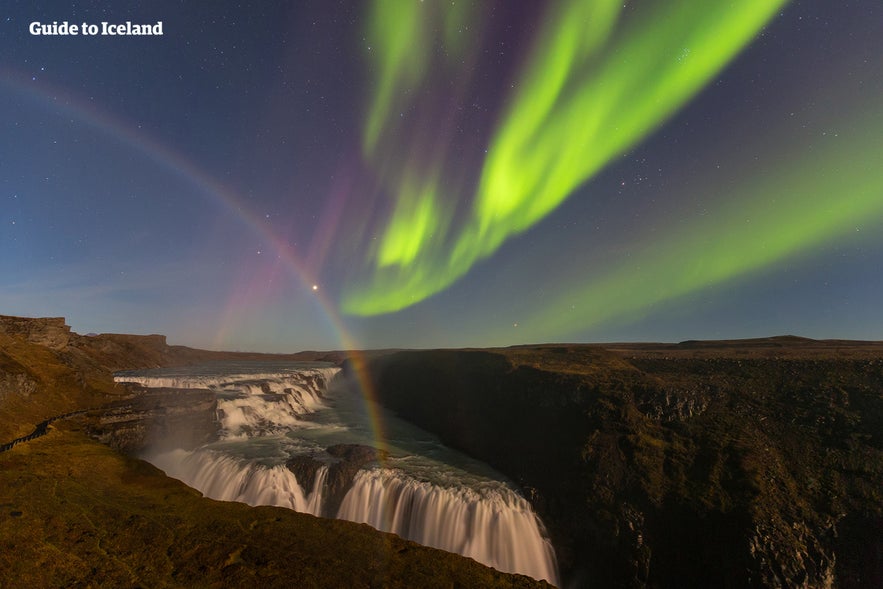 Yes, especially in early April. The nights are still dark enough in the first half of the month, which gives you a final chance to see the northern lights in Iceland in April before the aurora season ends.
Yes, especially in early April. The nights are still dark enough in the first half of the month, which gives you a final chance to see the northern lights in Iceland in April before the aurora season ends.
By late April, extended daylight hours make sightings more difficult, as the sky doesn’t stay dark long enough for the aurora to appear clearly. If you’re visiting in early April and the skies are clear, you might be in luck, especially if you venture away from city lights.
To improve your chances of seeing the northern lights in April in Iceland:
-
Stay in rural areas with low light pollution, especially at northern lights hotels.
-
Monitor the aurora forecast.
-
Choose a night with minimal cloud cover.
-
Join a guided tour that specializes in northern lights hunting.
Although April marks the end of the season, the elusive northern lights are worth chasing, especially when paired with fewer crowds and quieter landscapes. Choose a guided northern lights tour led by local experts to help you find the best spots for clear skies and active displays, particularly in early April.
Top 7 Things To Do in Iceland in April
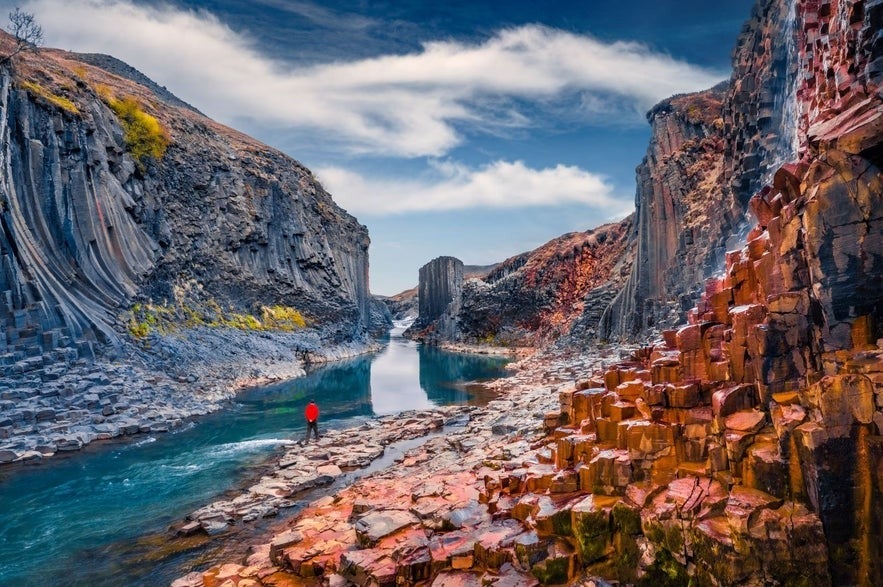 April opens up a wide range of things to do in Iceland in April as daylight increases and the country shifts from winter to spring. With longer days and improving weather, April offers travelers a mix of winter adventures and early spring experiences.
April opens up a wide range of things to do in Iceland in April as daylight increases and the country shifts from winter to spring. With longer days and improving weather, April offers travelers a mix of winter adventures and early spring experiences.
7. Go Bird Watching in Iceland in April

Coastal areas like Dyrholaey on the South Coast also see early movement as birds return to their breeding grounds. With fewer visitors around, you’ll enjoy calmer conditions and better opportunities for photography.
6. Visit East Iceland in April
 As conditions begin to improve by mid-April, East Iceland becomes a rewarding region to explore during your Iceland spring travel. Roads along the Eastfjords are generally maintained year-round, although you should still check weather conditions and road updates.
As conditions begin to improve by mid-April, East Iceland becomes a rewarding region to explore during your Iceland spring travel. Roads along the Eastfjords are generally maintained year-round, although you should still check weather conditions and road updates.
One of the best places to visit in Iceland in April is Seydisfjordur, a colorful fjord town known for its Rainbow Street and scenic walking path around the harbor. For dramatic landscapes, Studlagil Canyon is another strong option for its basalt formations and striking river gorge.
If you want a more relaxing experience, Vok Baths near Egilsstadir is open year-round and provides warm geothermal pools set on a serene lake. It’s an easy way to unwind between longer drives and a great addition to what to do in Iceland in April.
5. Spend Time in Reykjavik in April
Iceland’s capital is a great base for the month, with fewer crowds than in summer and a variety of things to do in Reykjavik in April. You can explore the city on foot and take advantage of the milder weather compared to the countryside.
You can visit the city’s highlights, such as Hallgrimskirkja Church, the Sun Voyager Sculpture, and Harpa Concert Hall. These sights are within walking distance, and the streets around Laugavegur and Skolavordustigur offer shops, cafes, and restaurants. Museums like the Whales of Iceland are a good option when the weather changes.
4. Explore Lava Caves in Iceland in April

A guided lava cave tour takes you through volcanic passages shaped by ancient eruptions, with colorful rock layers and seasonal ice features that often linger into early spring. These caves fit easily into many Iceland activities in April, with certified guides constantly checking access and safety before entering.
3. Soak in the Geothermal Hot Springs in Iceland in April
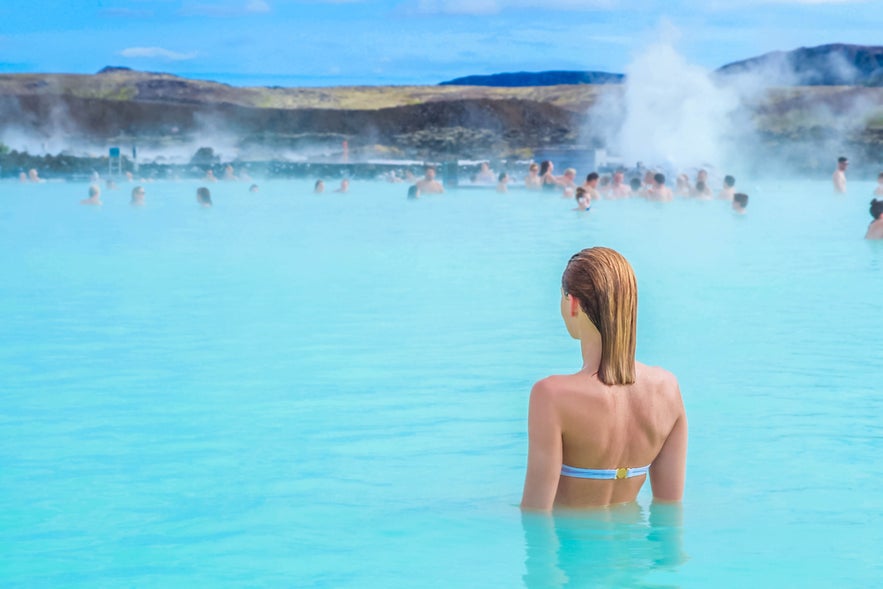 Relaxing in geothermal hot springs is one of the most enjoyable things to do in Iceland in April, especially when the air is still cool from winter. The Blue Lagoon on the Reykjanes Peninsula is the most famous option and works well at the beginning or end of a trip thanks to its location near Keflavik International Airport.
Relaxing in geothermal hot springs is one of the most enjoyable things to do in Iceland in April, especially when the air is still cool from winter. The Blue Lagoon on the Reykjanes Peninsula is the most famous option and works well at the beginning or end of a trip thanks to its location near Keflavik International Airport.
In the Reykjavik area, Sky Lagoon offers ocean views and a relaxing thermal experience that stays comfortable even on the crisp Icelandic April temperature. For travelers on the Golden Circle, the Secret Lagoon in Fludir provides a naturally fed geothermal pool with steady warmth and a quieter atmosphere.
2. Join a Glacier Hike in Iceland in April
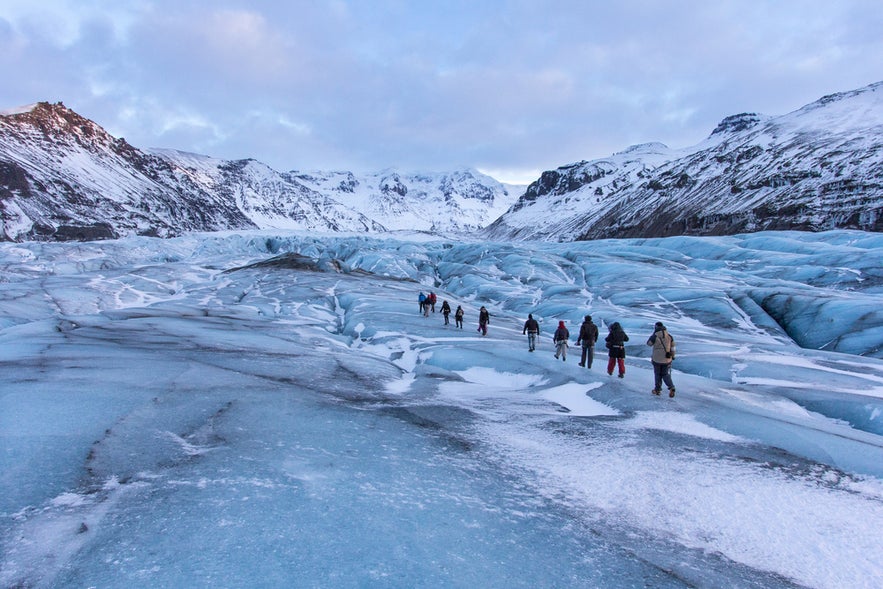 Glacier hiking is available year-round in Iceland, and April is a good time to join a guided glacier tour while the ice is still firm and the glacier surface has not shifted too much with spring melt. Solheimajokull on the South Coast is the most popular option, offering easy access from the Ring Road.
Glacier hiking is available year-round in Iceland, and April is a good time to join a guided glacier tour while the ice is still firm and the glacier surface has not shifted too much with spring melt. Solheimajokull on the South Coast is the most popular option, offering easy access from the Ring Road.
You can also join a glacier hike in the Vatnajokull Region around Skaftafell in Southeast Iceland, where spring conditions often reveal dramatic crevasse formations and wide stretches of open ice. Here, guided tours operate regularly in April, which makes it a reliable time to explore this part of the glacier.
1. Visit Iceland's Waterfalls in Full Spring Flow in April
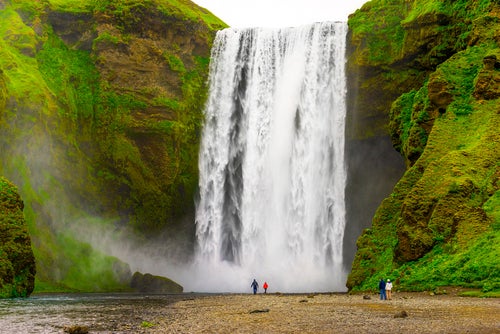 Visiting waterfalls is one of the most rewarding things to do in Iceland in April, and spring melt makes many of them even more powerful this month. Several regions across the country offer easy waterfall stops, all accessible on paved or well-maintained roads.
Visiting waterfalls is one of the most rewarding things to do in Iceland in April, and spring melt makes many of them even more powerful this month. Several regions across the country offer easy waterfall stops, all accessible on paved or well-maintained roads.
Along the South Coast, you can visit Seljalandsfoss, where the increased spring flow makes the walk-behind viewpoint especially dramatic. A short path leads to Gljufrabui, a partially hidden canyon waterfall. Farther east, Skogafoss surges with extra volume in April, and nearby Kvernufoss offers a quieter trail with a scenic backdrop.
The Golden Circle is another great area for Iceland spring travel, with Gullfoss remaining fully accessible throughout April. If you are exploring the north, Godafoss is a reliable stop in April, and late April often opens access to the west-side road of Dettifoss, one of Europe’s most powerful waterfalls.
Spring Festivals and Events in Iceland in April
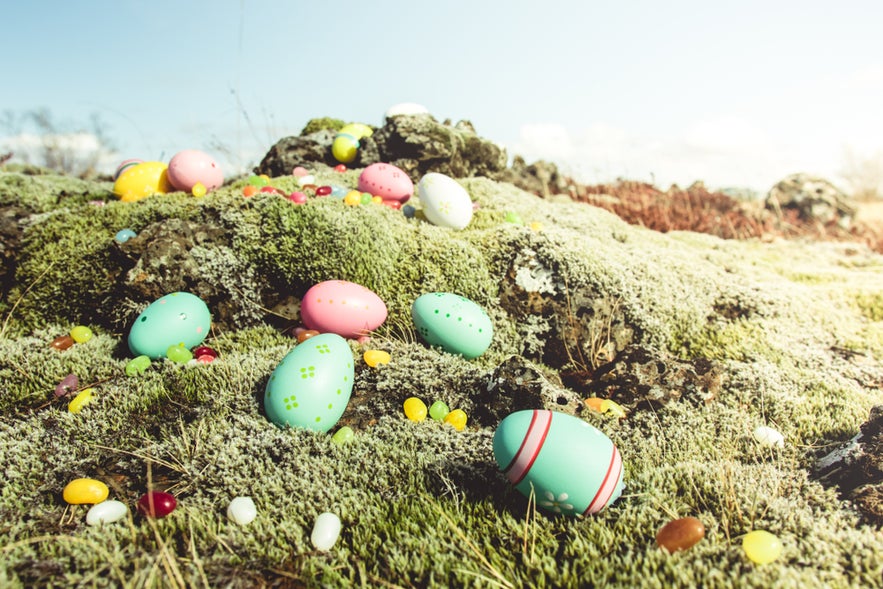 While April in Iceland may still carry traces of winter, the country’s festive spirit begins to bloom. Iceland’s spring festivals offer travelers a way to experience Icelandic culture, with options that highlight film, music, traditions, and family-friendly events. You’ll find things to do in Iceland in April that go beyond nature and into the heart of Icelandic creativity.
While April in Iceland may still carry traces of winter, the country’s festive spirit begins to bloom. Iceland’s spring festivals offer travelers a way to experience Icelandic culture, with options that highlight film, music, traditions, and family-friendly events. You’ll find things to do in Iceland in April that go beyond nature and into the heart of Icelandic creativity.
Stockfish Film Festival in Reykjavik
The Stockfish Film Festival takes place in late March or early April and offers a cultural addition to April activities in Iceland. The festival focuses on independent and arthouse cinema from Iceland and abroad, with films screened in English or with English subtitles.
Screenings, Q&A sessions, and industry talks make it accessible for travelers who want to explore Reykjavik’s creative scene. Held in venues around the city, the festival creates a relaxed way to engage with Icelandic film culture during your visit.
April Fools’ Day in Iceland
 April kicks off with a beloved tradition: April Fool’s Day, known locally as “Fyrsti April”. The holiday has European roots, and Icelanders have fully embraced it with clever pranks from local media who release playful fake stories. Don’t be surprised if you read a wild headline or get caught in a harmless trick while traveling on April 1.
April kicks off with a beloved tradition: April Fool’s Day, known locally as “Fyrsti April”. The holiday has European roots, and Icelanders have fully embraced it with clever pranks from local media who release playful fake stories. Don’t be surprised if you read a wild headline or get caught in a harmless trick while traveling on April 1.
Easter in Reykjavik in April
Easter is a festive and family-focused time, and it often aligns with Iceland spring travel. One of the most recognizable symbols is the Paskaegg, a large chocolate egg filled with candy and a small message inside. You’ll find them stacked in grocery stores, convenience stores, and bakeries throughout Reykjavik in the week leading up to the holiday.
Travelers visiting Iceland in April should plan ahead, as many businesses close for the long Easter weekend. Supermarkets usually operate on limited hours, and some restaurants stay open, especially in central Reykjavik.
Children’s Culture Festival in Reykjavik in April
The Children’s Culture Festival takes place each April in Reykjavik and is designed to highlight children as artists. Events are held across the city in schools, libraries, theaters, and other cultural venues. They offer hands-on experiences that fit naturally into Iceland spring travel and family-friendly activities in Reykjavik in April.
The program includes workshops, performances, exhibitions, and creative projects that invite children to participate directly. All events are free to attend, which makes it an easy cultural addition for families visiting Iceland in April.
Aldrei For Eg Sudur (Iceland’s Easter Music Festival in April)
Held each Easter weekend in the town of Isafjordur in the Westfjords, Aldrei For Eg Sudur is one of Iceland’s beloved music festivals. Founded by musician Mugison and his father in 2003, this event is free, open to the public, and a unique highlight during your Iceland spring travel.
The festival features a broad mix of musicians from across Iceland and has grown into a lively gathering that showcases local talent and the town’s cultural spirit. For travelers seeking local culture, Aldrei For Eg Sudur fits naturally into April activities in Iceland.
The First Day of Summer
Celebrated on the first Thursday after April 18, the First Day of Summer is an Icelandic holiday rooted in the old Norse calendar. Despite the often chilly weather, locals mark the occasion with outdoor festivities, parades, and community events that welcome the symbolic return of warmth and light.
Though it’s not technically summer by modern standards, the holiday reflects the national spirit of resilience and optimism as the country moves toward brighter days.
Driving in Iceland in April
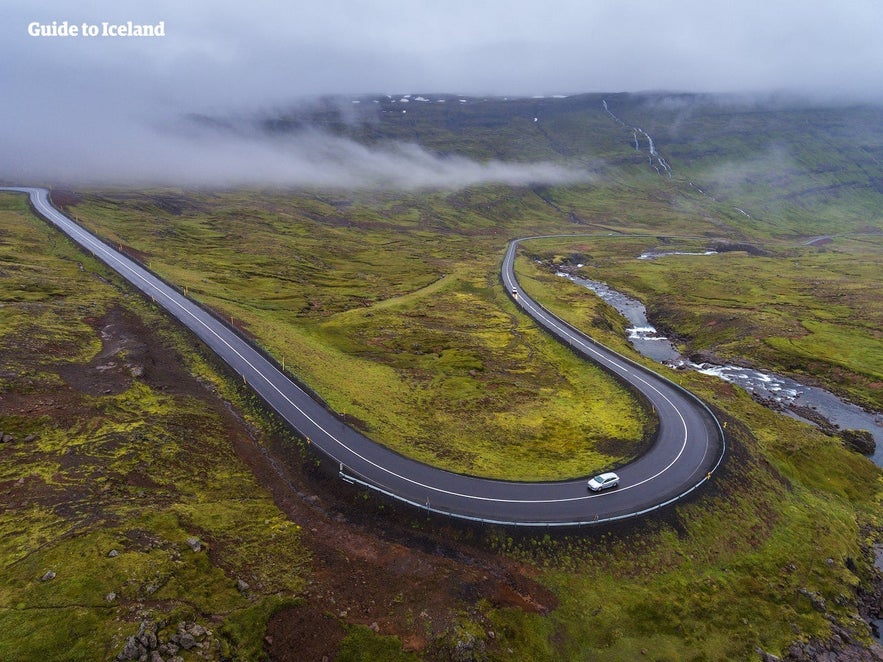
Roads That May Still Be Closed in Iceland in April
 Spring arrives unevenly, and Iceland's road conditions in April can vary dramatically between regions. Several roads typically remain closed. All F-roads, or Highland roads, stay shut until late June or July, which makes driving in the Highlands impossible in April.
Spring arrives unevenly, and Iceland's road conditions in April can vary dramatically between regions. Several roads typically remain closed. All F-roads, or Highland roads, stay shut until late June or July, which makes driving in the Highlands impossible in April.
Many mountain passes, especially in the Westfjords, may still be blocked by snow or become unsafe after storms. Some gravel connecting roads in the north and east can also remain closed or difficult to navigate, depending on weekly conditions.
Rental Car Advice for Iceland in April
 Checking Iceland road conditions in April is essential because conditions can shift quickly. If you plan to explore rural areas, 4x4 vehicle rentals are strongly recommended.
Checking Iceland road conditions in April is essential because conditions can shift quickly. If you plan to explore rural areas, 4x4 vehicle rentals are strongly recommended.
Many routes outside major towns combine gravel sections, potholes, wind exposure, and lingering ice. In early April, rental cars may still use studded winter tires, which help with traction on icy stretches.
Self-Drive Tours in April in Iceland
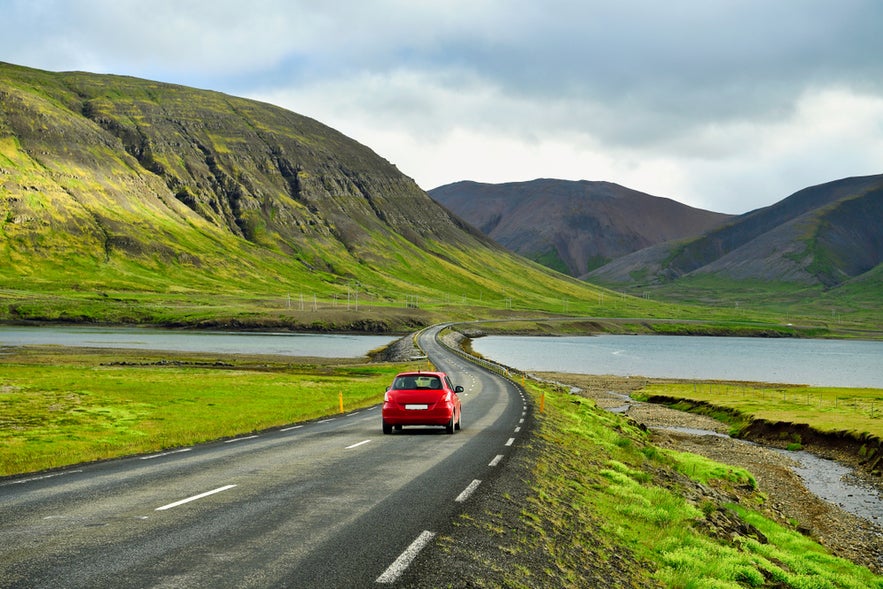 April brings longer daylight hours and lighter traffic, which makes it a good time for spring road trips to the South Coast, Snaefellsnes Peninsula, or Lake Myvatn, as long as the roads are open. With the right vehicle and proper planning, a spring drive through Iceland can be both scenic and memorable.
April brings longer daylight hours and lighter traffic, which makes it a good time for spring road trips to the South Coast, Snaefellsnes Peninsula, or Lake Myvatn, as long as the roads are open. With the right vehicle and proper planning, a spring drive through Iceland can be both scenic and memorable.
Here are some of the best options for self-drive tours in Iceland in April:
-
10-Day Self-Drive Tour of the Ring Road: Explore the country’s most iconic regions with a pre-planned itinerary, accommodations, and a rental car included.
-
6-Day Self-Drive Tour With the Golden Circle, Blue Lagoon, & Jokulsarlon Glacier Lagoon: This itinerary is packed with adventure. It gives you the freedom to explore Iceland’s natural wonders and chase waterfalls, glaciers, and black sand beaches.
-
1-Week Self-Drive Tour of South Iceland and the Golden Circle: This weeklong journey pairs iconic stops with lesser-known gems. Experience the magic of secret canyons, geothermal springs, and sweeping coastal roads at your own pace.
Guided Tours and Vacation Packages in Iceland in April
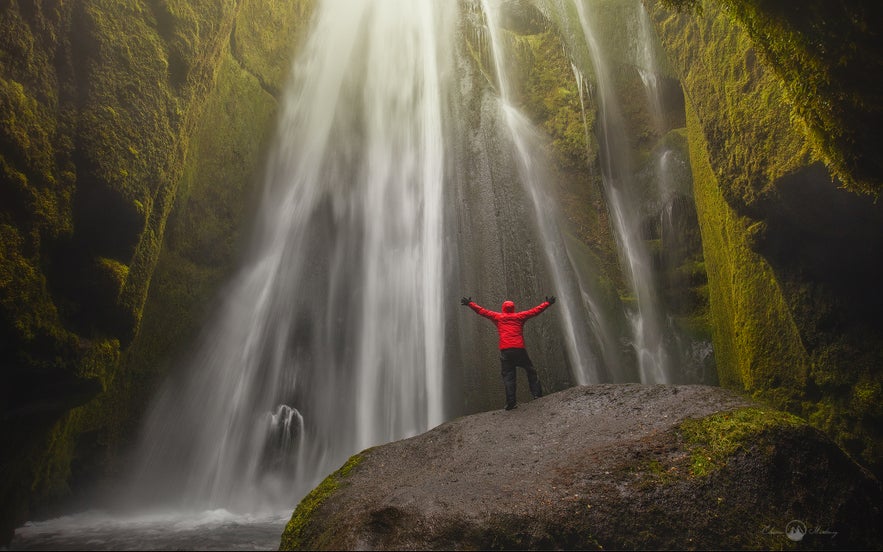 Just because spring is a great time for a road trip across Iceland doesn’t mean you have to navigate your entire vacation on your own. There are plenty of guided tours and vacation packages to take the stress of planning and travel logistics out of the equation.
Just because spring is a great time for a road trip across Iceland doesn’t mean you have to navigate your entire vacation on your own. There are plenty of guided tours and vacation packages to take the stress of planning and travel logistics out of the equation.
Best Guided Tours in Iceland in April
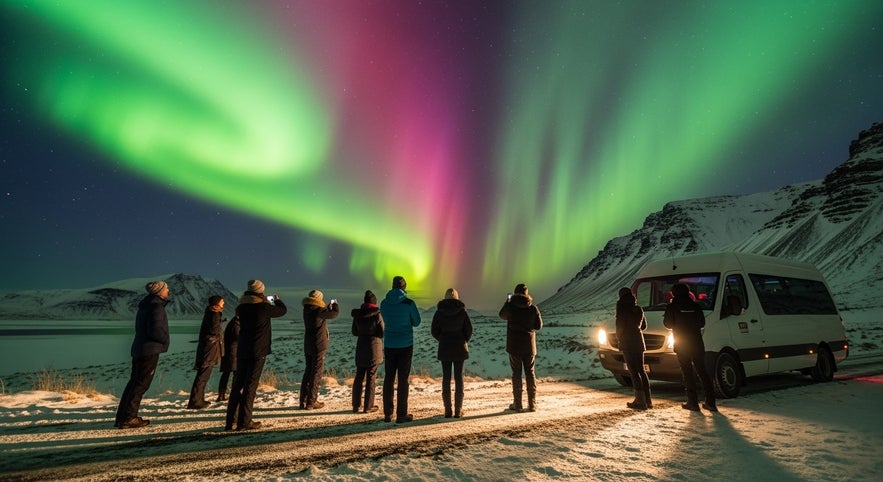 Guided tours are ideal if you want everything handled for you. They include transportation, a professional guide, accommodations, and a fully pre-planned itinerary, so you can enjoy Iceland without worrying about logistics. Choose from these top selections:
Guided tours are ideal if you want everything handled for you. They include transportation, a professional guide, accommodations, and a fully pre-planned itinerary, so you can enjoy Iceland without worrying about logistics. Choose from these top selections:
-
2-Day South Coast Tour: Explore waterfalls, black-sand beaches, and glaciers on a two-day journey along the South Coast.
-
3-Day Northern Lights & Ice Cave Multi-Day Tour: Combine South Coast highlights with an ice-cave tour and dedicated northern lights hunting.
-
8-Day Guided Tour of the Complete Ring Road: A full loop around Iceland covering waterfalls, glaciers, geothermal areas, lava fields, national parks, and winter landscapes.
Most Popular Vacation Packages in Iceland in April
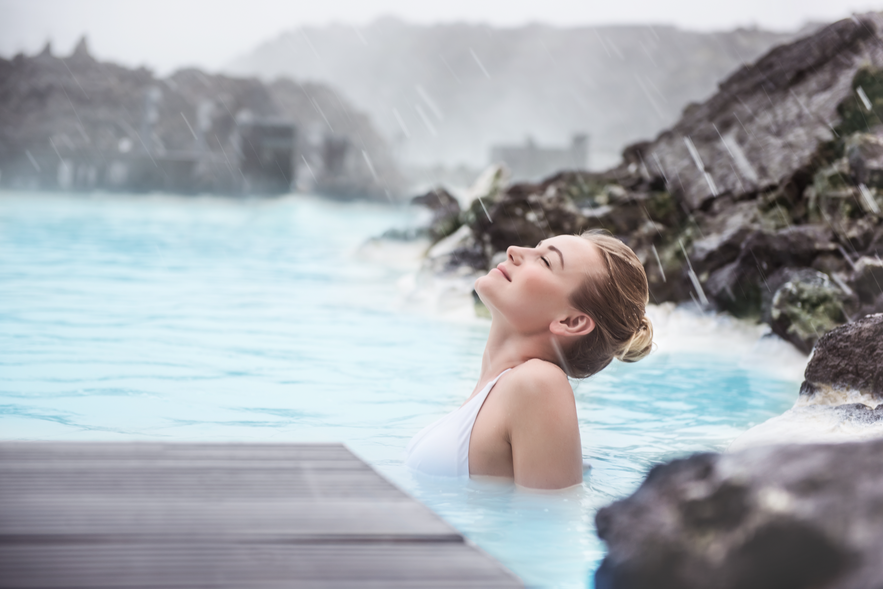 Vacation packages offer transportation and accommodations with the added flexibility to customize your activities. They give you structure while still allowing you to choose experiences that match your interests. Here are the best options:
Vacation packages offer transportation and accommodations with the added flexibility to customize your activities. They give you structure while still allowing you to choose experiences that match your interests. Here are the best options:
-
3-Day Northern Lights Package With the Golden Circle & Blue Lagoon: Experience the Golden Circle, relax at the Blue Lagoon, and join dedicated northern lights outings.
-
4-Day Northern Lights Package With Golden Circle & South Coast: Explore the Golden Circle and South Coast while chasing the northern lights.
-
5-Day Package in Iceland With Jokulsarlon Glacier Lagoon & Golden Circle: See Iceland’s top attractions, including the Golden Circle, South Coast waterfalls, and Jokulsarlon Glacier Lagoon.
What To Pack for Iceland in April
Packing for Iceland in April means preparing for just about anything. The weather may hint at spring, but snowstorms, rain, and chilly winds can arrive with little warning. If you are wondering what to wear in Iceland in April, the key is planning for all seasons in one trip.
Here is the list of what to pack for Iceland in April:
-
Layering basics: Start with thermal base layers (top and bottom), add insulating mid-layers like fleece or wool, and finish with a waterproof and windproof outer shell.
-
Sturdy footwear: Waterproof hiking boots with good traction are a must, especially if you plan to visit waterfalls, icy trails, or muddy terrain.
-
Weather-appropriate accessories: Pack a hat, gloves, scarf, and warm socks. A compact umbrella is not helpful because of the strong wind, but a waterproof hood will serve you well.
-
Daylight-ready gear: With longer days, sunglasses, sunscreen, and a reusable water bottle will come in handy.
-
Optional but helpful: Crampons or slip-on ice cleats, especially for early April, when sidewalks and hiking paths may still be icy.
Even if the sun shines for hours, it’s not summer yet, and Iceland’s weather in April can change by the hour. Prepare for sun, sleet, wind, and snow in a single day, and you will be ready for anything when you know what to wear in spring in Iceland.
FAQs About Visiting Iceland in April
Planning a trip to Iceland in April comes with plenty of questions. Below are answers to some common questions travelers ask about visiting Iceland during this transitional month.
Is April a good time to visit Iceland?
Yes, April is a great time to visit Iceland, especially if you're looking to avoid peak-season crowds and enjoy more affordable travel. The days are longer, popular attractions are more accessible, and spring festivals start to pick up.
The weather can still be unpredictable, and some remote roads may be closed, especially in the Westfjords and Highlands. April is ideal for travelers who want a quieter experience and are willing to adapt to Iceland’s famously changeable climate.
What to expect in Iceland in April?
April is a transitional month with longer daylight hours, mixed weather, and gradually improving road access in the south and west. It’s a great time for photography thanks to clear air and soft spring light. Overall, April offers quieter travel, fewer crowds, and a balance of winter and spring scenery, which makes it a rewarding time to explore Iceland.
Can you still see snow in Iceland in April?
Yes, snow is still very common in April, especially in the north and at higher elevations. Even in Reykjavik, it’s not unusual for a spring snowstorm. However, April also brings the first signs of thawing, revealing patches of green grass and increasing the flow of waterfalls fed by melting snow. This mix is typical of Iceland's weather in April.
What to pack if you rent a campervan in April?
For those who will rent campervans in Iceland, bring an extra warm layer for evenings, an insulated sleeping bag, a power bank, and moisture-resistant clothing bags. Nights can still be cold in April, so being prepared is important for comfort and safety.
Is anything closed in April in Iceland?
Most popular attractions and tours are open in April and often with reduced crowds. However, F-roads remain closed, and some mountain passes in the Westfjords or East Iceland may still be closed. If you're visiting Iceland at Easter, expect reduced opening hours for supermarkets and restaurants, though many essential services remain open.
Plan Your April Trip to Iceland
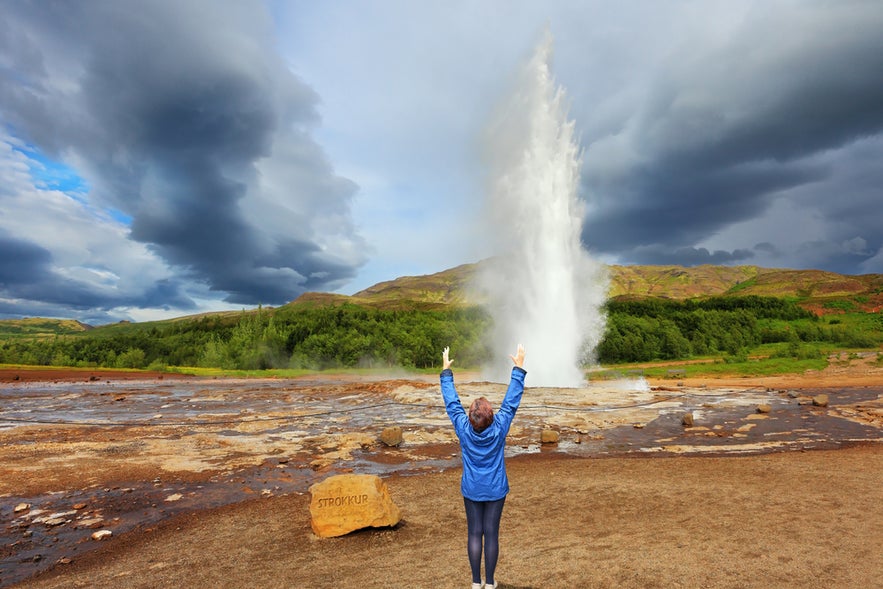 April is one of the most overlooked times to experience Iceland. The days grow noticeably longer, patches of green begin to reappear, and the last traces of winter still shape the landscape. This mix of seasons gives Iceland in April a fresh, quiet energy that many travelers miss during busier months.
April is one of the most overlooked times to experience Iceland. The days grow noticeably longer, patches of green begin to reappear, and the last traces of winter still shape the landscape. This mix of seasons gives Iceland in April a fresh, quiet energy that many travelers miss during busier months.
Visiting Iceland in April offers flexibility and variety. Many waterfalls reach full spring flow, hot springs feel especially inviting, and early migratory birds begin to return. Road trips along the South Coast and Golden Circle become easier as conditions improve, and April festivals bring music, film, and family-friendly activities.
Northern lights are still possible in early April, and daylight grows quickly, creating excellent conditions for photography tours. These combined experiences make Iceland spring travel a strong choice for travelers searching for the best time to visit Iceland without peak-season crowds.
If you are thinking about visiting Iceland in April, tell us which tours or experiences interest you most. Share your ideas in the comments, and let us know what you're most exciting about your spring trip to Iceland.





